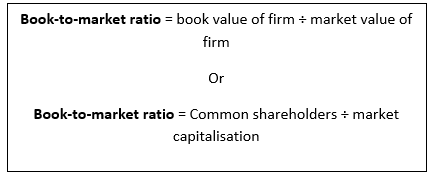Definition
Related Definitions
Book-to-Market
What is the meaning of Book-to market?
The book-to-market refers to the ratio that is used to find out the value of an organisation by measuring the book value of an organisation to its market value. Market value of an organisation is determined from the price of its stock through market capitalisation. Book value refers to the accounting value of an organisation as showed in its balance sheet.

Source: Copyright © 2021 Kalkine Media Pty Ltd
Understanding Book to market ratio
Before investing in a company, investors calculate the book-to-market ratio. Book-to-market ratio is useful to determining the value of a firm. It is a ratio that is used by an investor or analyst to find out the value of a firm. It is calculated by estimating the book value of a firm by its market value. Book value is determined by firm's historical cost, or accounting value. Market value is calculated by multiplying number of shares with its market price, it is also known as market capitalisation.

Source: Copyright © 2021 Kalkine Media Pty Ltd
Frequently Asked Questions (FAQs)
How does the book-to-market ratio help traders?
Traders use the book-to-market ratio work as an indicator to know whether a stock of a company is under or overvalued. If the market value of a company is more than its book value, traders or investor considered that company is currently overvalued. On the contrary side, traders or investor considered a company is undervalued, if the market value of a company is less than its book value.
Traders or investors compare the ratio with the base of 1. If the book-to-market ratio of a stock is more than one, the stock considered as undervalued. It shows that the stock of a company is trading for less than the total value of its assets. And if it is less than 1, it means the stock is overvalued as it shows that a firm’s stock is trading for more than the total value of its assets.
The book value of a company defines accounting value or historical cost which is calculated from the balance sheet of a company. It can be calculated by subtracting the total liabilities from the total assets of a company. Book value refers to the net value of a company’s assets showed on balance sheet.
The market value of a company is finding by calculating its market capitalisation which is calculated by multiplying the total number of shares with the current share price. The market value refers to the price that an investor is wants to pay to buy or sell the stock. The market value does not represent the actual value of a company because it is determined by supply and demand in the market.
How investors interpret the book-to-market ratio?
The book-to-market ratio helps investors to identify whether a company is undervalued or overvalued by dividing the book value with its market value. The ratio tells the market value of an organization relation to its actual worth. This ratio helps Investors and analysts to know the true value of an organization.
If a book-to-market ratio of a firm is more than 1, then the stock of firm is considered as undervalued. It shows that the stock of a company is trading for less than the total value of its assets.
On the other side, if a book-to-market ratio of a firm is less than 1, then the stock of firm is considered as overvalued, it shows that an investor is wants to pay more than the worth of net assets of a firm. It shows the future profit possibilities and investors wants to pay even more for that possibility. Companies have a low book-to-market ratio such as IT companies and other companies that do not have more tangible assets.
For example, an investor wants to calculate the book-to-market ratio of ABC Company. Company has stock of equity £4 billion, and £1billion as its market capitalization. To calculate the ratio for company ABC, investor would divide £4 billion by £1billion, which would the book-to-market ratio 4. The ratio is more than one that indicates ABC Company is currently undervalued.
What is the difference Between the Book-to-Market Ratio and Market-to-Book Ratio?
The market-to-book ratio also known as price-to-book ratio used by investors to know whether a firm's stock is over or undervalued. Market-to-book ratio is calculated by dividing the market price of all outstanding shares with the net assets of the company.
The market-to-book ratio is the reverse of the book-to-market ratio, it is used by a trader to know an organization’s current market value respective to its book value.
The market value refers to the current stock price of all outstanding shares (company’s worth).
A market-to-book ratio compared with base 1, if ratio is more than 1 that means stock of a firm is overvalued and if a ratio is less than 1 that means a firm is undervalued; it is just opposite for the book-to-market ratio. Investors and analysts may use both the ratio to know a company’s worth by comparison on the market and book value of a firm.
The market-to-book ratio is the opposite of the book-to-market ratio, in Market to book ratio the common shareholder equity dividing by market capitalization and in market-to-book the market capitalization divides by the common shareholder equity. Market-to-book ratio mainly used for the companies who have more intangible assets such as financial institutions, insurance and, investment trusts and so on.
The market-to-book ratio can be calculated by dividing the Share Price (current closing price of the stock) by the Net Book Value per Share (most current quarter’s book value). Closing price of the stock (Net book value) can be calculated by subtracting total assets with total liabilities.

Source: Copyright © 2021 Kalkine Media Pty Ltd
